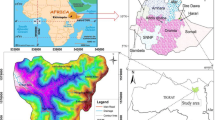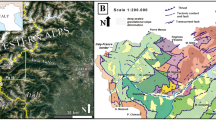Abstract
Unfavorable orientations of geological discontinuities and their geometrical relationship with the topographic slopes play a crucial role in controlling slope instability. This study developed a GIS-based kinematic model based on the mutual relationship between topographic slope and geological discontinuities to delineate rockfall zones and understand their spatial association with debris slide head scars in the Anakeesta rock formation of the Great Smoky Mountains National Park, Tennessee, USA. We mapped the exposed debris slide head scars from aerial photographs, satellite imagery, and field surveys and orientations of geological discontinuities were measured from the field along with other geotechnical parameters. Findings revealed the presence of four distinct sets of discontinuities, resulting in 11 possible slope failure mechanisms that could predict 57% of the existing debris slide. Wedge failure was the most prominent mode of slope failure, with wedge forming between the bedding plane and a joint set predicted for 27% of all failures in the debris slide head scars. The final rock kinematical susceptibility model was developed using the cumulative prediction capacity of individual discontinuity-driven kinematical rockfall failures through a weighted sum analysis. The model classified 77.9% of the area as safe, 14.7% to be moderately, and 7.4% as highly prone to kinematical rockfall failure. The susceptibility model was validated using the receiver operating characteristic curve on test data, which yielded an area under the curve (AUC) value of 65%, indicating a discriminatory power of the model separating the debris slide and non-debris slide scars. Finally, the spatial association between the kinematical susceptibility model and existing debris slide was statistically confirmed through a spatial Kolmogorov–Smirnov test of complete spatial randomness, signifying the role of kinematic rockfalls in generating the debris slide scars in the study area.












Similar content being viewed by others
Data availability
The data that support the findings of this study are available from the corresponding author, Arpita Nandi, upon reasonable request.
References
Allmendinger RW, Cardozo N, Fisher D (2012) Structural geology algorithms: vectors and tensors in structural geology: Cambridge University Press (book to be published in early 2012)
Baddeley A, Turner R, Møller J, Hazelton M (2005) Residual analysis for spatial point processes (with discussion). J R Stat Soc 67(5):617–666
Baer P, Huggel C, McArdell BW, Frank F (2017) Changing debris flow activity after sudden sediment input: a case study from the Swiss Alps. Geol Today 33(6):216–223
Bieniawski ZT (1989) Engineering rock mass classifications: a complete manual for engineers and geologists in mining, civil, and petroleum engineering: New York, Wiley
Bogucki DJ (1970) Debris slides and Related Damaae Associated with the September 1, 1951 Cloudburst in the Mt. Leconte-Sugarland Mountain Area, Great Smoky Mountains National Park (Doctoral dissertation, Doctoral Dissertation, University of Tennessee, Knoxville)
Cerri RI, Reis FAGV, Gramani MF, Rosolen V, Luvizotto GL, Giordano LC, Gabelini BM (2018) Assessment of landslide occurrences in Serra do Mar mountain range using kinematic analyses. Environ Earth Sci 77:1–16
Clark GM (1987) Debris slides and debris flow historical events in the Appalachians south of the glacial border. Rev Eng Geol 7:125–138
Cruden DM (1989) Limits to common toppling. Can Geotech J 26:737–742
Das R, Nandi A, Joyner A, Luffman I (2021) Application of GIS-based knowledge-driven and data-driven methods for debris-slide susceptibility mapping. Int J Appl Geospat Res (IJAGR) 12(1):1–17
Davies TR, Korup O (2007) Persistent alluvial fanhead trenching resulting from large, infrequent sediment inputs. Earth Surf Proc Land 32(5):725–742
Eschner AR, Patric JH (1982) Debris avalanches in eastern upland forests. J Forest 80:343–347
Evans SG, Bishop NF, Smoll LF, Murillo PV, Delaney KB, Oliver-Smith A (2009) A re-examination of the mechanism and human impact of catastrophic mass flows originating on Nevado Huascarán, Cordillera Blanca, Peru in 1962 and 1970. Eng Geol 108(1–2):96–118
Fawcett T (2006) An introduction to ROC analysis. Pattern Recogn Lett 27:861–874
Frattini P, Crosta G, Carrara A, Agliardi F (2008) Assessment of rockfall susceptibility by integrating statistical and physically-based approaches. Geomorphology 94(3–4):419–437
Ghosh S, Günther A, Carranza EJM, van Westen CJ, Jetten VG (2010) Rock slope instability assessment using spatially distributed structural orientation data in Darjeeling Himalaya, India. Earth Surf Process Landforms 35(15):1773–1792. https://doi.org/10.1002/esp.2017. (1773)
Gokceoglu C, Sonmez H, Ercanoglu M (2000) Discontinuity controlled probabilistic slope failure risk maps of the Altindag (settlement) region in Turkey. Eng Geol 55(4):277–296
Goodman RE (1989) Introduction to rock mechanics, 2nd edn. John Wiley and Sons Inc, New York
Goodman RE, Bray JW (1976) Toppling of rock slopes. In: Rock engineering: American society of civil engineers, geotechnical engineering division conference, boulder, Colorado, Vol. II, pp 201–234
Günther A (2003) SLOPEMAP: programs for automated mapping of geometrical and kinematical properties of hard rock hill slopes. Comput Geosci 29(7):865–875
Hauser A (2002) Rock avalanche and resulting debris flow in Estero Parraguirre and Rio Colorado, Regio’n Metropolitana, Chile. Catastrophic landslides: effects, occurrence and mechanisms. Geol Soc Am Rev Eng Geol 15:135–148
Henderson JP (1997) Debris slide susceptibility analysis in the Mt. LeConte-newfound gap area of the great smoky mountains, Tennessee and North Carolina. Unpublished Master’s Thesis, The University of Tennessee, Knoxville
Hoek E, Bray JW (1981) Rock slope engineering. Institution of Mining and Metallurgy, London
Hong SK, Park HJ (2019) Probabilistic kinematic analysis of rock slope stability using terrestrial lidar. Econ Environ Geol 52(3):231–241. https://doi.org/10.9719/EEG.2019.52.3.231
Hungr O, Evans SG (2004) Entrainment of debris in rock avalanches: an analysis of a long run-out mechanism. Geol Soc Am Bull 116(9–10):1240–1252
Hupp CR (1983) Seedling establishment on a landslide site. Castanea 48:89–98
Kanno H, Moriguchi S, Tsuda Y, Yoshida I, Iwanaga S, Terada K (2023) A method for rockfall risk quantification and optimal arrangement of protection structures along a road. Eng Geol 314:107004
King PB, Jarvis BH, Robert B, Neuman WH (1958) Stratigraphy of the Ocoee series, great smoky mountains, Tennessee and North Carolina. Geol Soc Am Bull 69:947–966
King PB, Neuman RB, Hadley JB (1968b) Geology of the great smoky mountains national park, Tennessee and North Carolina, Geological Survey Professional Paper 587. Government Printing Office, Washington
King PB, Neuman RB, Hadley JB (1968) Geology of the Great Smoky Mountains National Park, Tennessee and North Carolina. U. S. Geol. Surv. Prof. Pap. 587
Kundu J, Sarkar K, Ghaderpour E, Scarascia Mugnozza G, Mazzanti P (2023) A GIS-based kinematic analysis for jointed rock slope stability: an application to Himalayan slopes. Land 12(2):402
Lee S (2005) Application of logistic regression model and its validation for landslide susceptibility mapping using GIS and remote sensing data. Int J Remote Sens 26(7):1477–1491
Loye A, Jaboyedoff M, Pedrazzini A (2009) Identification of potential rockfall source areas at a regional scale using a DEM-based geomorphometric analysis. Nat Hazard 9(5):1643–1653
Luckman BH (2013) 7.17 Processes, transport, deposition, and landforms: Rockfall
Markland JT (1972) A useful technique for estimating the stability of rock slopes when the rigid wedge sliding type of failure is expected. Imperial College Rock Mechanics, Reserach Report, no. 19. Imperial College Press, London
Matheson GD (1983) Rock stability assessment in preliminary site investigations—graphical methods, report 1039. Transport and Road Research Laboratory, Crownthorne
Melzner S, Rossi M, Guzzetti F (2020) Impact of mapping strategies on rockfall frequency-size distributions. Eng Geol 272:105639
Moore HLA (1988) A roadside guide to the geology of the great smoky mountains national park. University of Tennessee Press, Knoxville, p 178
Nandi A, Shakoor A (2017) Predicting debris flow initiation zone using statistical and rock kinematic analysis, a case study from West Prong Little Pigeon River, TN, NASL Proceedings, 2017
Nandi A, Shakoor A (2010) A GIS-based landslide susceptibility evaluation using bivariate and multivariate statistical analyses. Eng Geol 110:11–20. https://doi.org/10.1016/j.enggeo.2009.10.001
Nikoobakht S, Azarafza M, Akgün H, Derakhshani R (2022) Landslide susceptibility assessment by using convolutional neural network. Appl Sci 12(12):5992
Olea RA, Pawlowsky-Glahn V (2009) Kolmogorov–Smirnov test for spatially correlated data. Stoch Env Res Risk Assess 23(6):749–757
Palmstrøm A (1982) The volumetric joint count—a useful and simple measure of the degree of rock mass jointing. IAEG Congress, New Delhi, p V.221-V.228
Park HJ, Lee JH, Kim KM, Um JG (2016) Assessment of rock slope stability using GIS-based probabilistic kinematic analysis. Eng Geol 203:56–69
Pignalosa A, Forte G, Budetta P, Santo A (2022) Topographic amplification and debris remobilization as a cause for increasing rockfall hazard in seismic areas: a case study in Central Italy. Geomorphology 403:108160
Roy S, Mandal N (2009) Modes of hillslope failure under overburden loads: insights from physical and numerical models. Tectonophysics 473:324–340
Ryan PT (1989) Debris slides and flows on anakeesta ridge within the great smoky mountains national park Tennessee, USA. Unpublished Master's Thesis, The University of Tennessee, Knoxville
Southworth S, Schultz A, Denenny D (2005) Geologic map of the great smoky mountains national park region, Tennessee and North Carolina. US Geological Survey Open File Report 2005–1225, scale 1:100,000
Varnes DJ (1978) Slope movements: types and processes. In: Schuster RL and Krizek RJ (eds) Landslide analysis and control, transportation research board, special report 176. Washington, DC, 11–33
Walter F, Amann F, Kos A, Kenner R, Phillips M, de Preux A et al (2020) Direct observations of a three million cubic meter rock-slope collapse with almost immediate initiation of ensuing debris flows. Geomorphology 351:106933
Wang Z, Liu Q, Liu Y (2020) Mapping landslide susceptibility using machine learning algorithms and GIS: a case study in Shexian County, Anhui Province. China Symmetry 12(12):1954
Wieczorek GF, Morgan BA, Campbell RH (2000) Debris-flow hazards in the Blue Ridge of central Virginia. Environ Eng Geosci 6(1):3–23
Xu J, Jiang Y, Yang C (2022) Landslide displacement prediction during the sliding process using XGBoost. SVR and RNNs Applied Sciences 12(12):6056
Yan J, Chen J, Li Y, Li Z, Zhang Y, Zhou X, Mehmood Q, Liu J, Wang Z (2022) Kinematic-based failure angle analysis for discontinuity-controlled rock slope instabilities: a case study of Ren Yi Peak Cluster in Fusong County, China. Nat Hazards 111(3):2281–2296. https://doi.org/10.1007/s11069-021-05137-2
Yoon WS, Jeong UJ, Kim JH (2002) Kinematic analysis for sliding failure of multi-faced rock slopes. Eng Geol 67(1–2):51–61
Zhao Y, Wang L, Li H (2020) Effect of freeze-thaw on the stability of a cutting slope in a high-latitude and low-altitude permafrost region. Appl Syst Innov 3(3):36
Zimmer VL, Collins BD, Stock GM, Sitar N (2012) Rockfall dynamics and deposition: an integrated analysis of the 2009 Ahwiyah Point rock fall, Yosemite National Park, USA. Earth Surf Proc Land 37(6):680–691
Web Reference
Funding
This research was supported by East Tennessee State University, U.S. National Park Service.
Author information
Authors and Affiliations
Contributions
A collected the field and geospatial data B provided mentoring throughout this research A, B did the major kinematic analysis C, D provided input on geospatial analysis A, B, C, D wrote the main manuscript text A prepared the figures. All authors reviewed the manuscript.
Corresponding author
Ethics declarations
Conflict of interest
The authors declare no competing interests.
Additional information
Publisher's Note
Springer Nature remains neutral with regard to jurisdictional claims in published maps and institutional affiliations.
Rights and permissions
Springer Nature or its licensor (e.g. a society or other partner) holds exclusive rights to this article under a publishing agreement with the author(s) or other rightsholder(s); author self-archiving of the accepted manuscript version of this article is solely governed by the terms of such publishing agreement and applicable law.
About this article
Cite this article
Das, R., Nandi, A., Luffman, I. et al. Assessment of discontinuity-controlled rock slope instability for debris slide initiation: a GIS-based kinematical analysis in the Great Smoky Mountains National Park, TN, USA. Environ Earth Sci 83, 284 (2024). https://doi.org/10.1007/s12665-024-11578-2
Received:
Accepted:
Published:
DOI: https://doi.org/10.1007/s12665-024-11578-2




